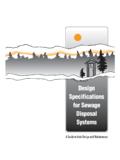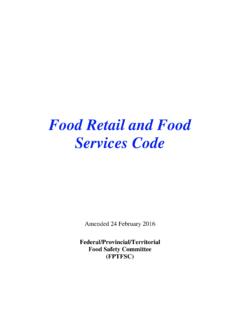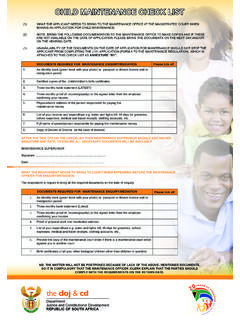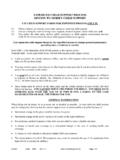Transcription of Guidelines and Policies for Child Care and Family …
1 Guidelines AND Policies FOR Child CARE AND Family DAYHOME PROGRAMS TABLE OF CONTENTS ITABLE OF CONTENTS HEALTH 3 Nutritional Guidelines 3 Guidelines for Food Service 4 Sample Weekly Menu #1 5 Sample Weekly Menu #2 6 Guidelines for Snacks and Lunches In Child Care Centres 7 Guidelines for Communicable Diseases 10 Exclusion From Child Care Services: 10 TB 11 RASHES 11 LICE 11 Guidelines For Handwashing, Toileting & Diapering 12 When To Handwash 12 Handwashing For Children 12 Toileting Procedure 13 Diaper Changing Procedure 13 Sick Child Policy 14 Medication Policy 15 Medication Record Sheet 16 Guidelines for Maintenance of Pets 17 SAFETY 18 Emergency Procedures 18 An Emergency Plan 19 Fire Drill Record 20 Emergency Phone Numbers 21 Emergency Records 21 Emergency Record 22 Parental Consent for Emergency Care and Transportation 23 First Aid Practices 24 Reporting Accidents 25 Accident Report 26 AMINISTRATION
2 28 Administration And Records Guidelines 28 Child Information Record 29 Attendance Records 30 Attendance Record 31 Daily Attendance Record 32 Financial Guidelines 33 Sample Budget Worksheet For Child Care Program 34 Budget/Actual Comparison 35 Staff Manual 36 Parent/ Family Handbooks and Agreements 37 Family Day Home Contracts 38 TABLE OF CONTENTS IIPROGRAMMING 39 Guidelines for Programming 39 Program Planning and Review 40 Child Care Program Review 41 Child Care Program Daily Review 42 Guidelines For Maximum Group Size 44 Field Trip Guidelines 45 Outing Record Form 46 Guidelines for Behaviour Management 47 Guidelines For Anti Bias Curriculum 48 Guidelines For Supervision 49 Supervision Policy for School Age Children 49 MAINTENANCE 50 Guidelines For Maintenance Of Equipment And Furnishings 50 Guidelines for Maintenance of Indoor Space 53 Cleaning Checklist 55 Guidelines for
3 Maintaining Space and Equipment Outdoors 57 Playground Safety Checklist 58 COMMUNICATION 65 Parental Involvement Guidelines 65 Confidentiality Guidelines 66 Abuse and Neglect Reporting Policies 67 Child Abuse Protocol Roles and Responsibilities 67 Incident Reporting 69 Incident Report Form 70 PERSONNEL INFORMATION 71 Job Description 71 Job Evaluations 71 Child Care Facility Employee Orientation Guide 72 Employee Relations 73 Early Childhood Training 74 Child Care Workers Levels 74 Staff Qualification Check List 75 CARING FOR THE CAREGIVER 76 Guidelines AND Policies FOR Child CARE AND Family DAYHOME PROGRAMS HEATH NUTRITIONAL Guidelines PAGE 3 OF 77 HEALTH NUTRITIONAL Guidelines INTRODUCTION: The Child Care Centre Regulations (Section 15 1 to 9) and the School Age Program Regulations (Section 15 1 to 4) specify what snacks and meals are required for children attending full and part day programs.
4 The operator of a Child care program shall ensure that all children have a morning, mid-day or evening meal that includes at least a serving from each of the following four (4) food groups: 1. Grain Products including breads, cereals, pasta, rice and bannock. 2. Milk, Bone and Milk Products including cheese and yogurt, fish with crushed bones, such as canned salmon. 3. Vegetables, Fruits, and Berries. 4. Meat, Fish, Birds, Eggs and Alternatives, including beans, nuts, tofu and nut butters. A mid morning, mid afternoon or mid evening nutritional snack must be supplied that includes at least one serving from each of the two (2) food groups for children in attendance at those times.
5 School age children must be supplied with an after school snack as above. Canada's Food Guide and/or the Native Food Guide shall be used as guides. Copies are available from the nutritionist, Whitehorse General Hospital or from Child Care Services Unit. Foods high in sugar, salt, fats and/or nitrates are to be used in moderation and never to replace foods from the 4 food groups. All foods shall be prepared, stored and served under sanitary conditions. An adequate supply of potable water shall always be available to children. Foods supplied from home shall be stored and served under sanitary conditions.
6 Items which may be perishable within the time they were prepared, and intended to be eaten, shall be refrigerated. The operator of a Child care facility shall ensure such foods are stored correctly. Foods may be supplied from home but the operator of the centre has final responsibility to ensure that they are in accordance with these Guidelines . Infants must eat and drink according to their own individual schedule. A consistent adult figure shall be maintained whenever possible. Menus must be posted and followed and kept on file for three months. If foods are supplied from home a checklist must be maintained to ensure that all requirements are met.
7 Any foods that are supplemented by the Child care centre program must be recorded and kept on file. Guidelines AND Policies FOR Child CARE AND Family DAYHOME PROGRAMS HEATH Guidelines FOR FOOD SERVICE PAGE 4 OF 77 Guidelines FOR FOOD SERVICE INTRODUCTION If a Child care centre serves hot meals, the following Guidelines should be followed in order to ensure that children and staff are kept safe from food poisoning and contamination. Only food from an approved source may be served. Farm produced foods ( eggs, milk and/or meat that are obtained from farm animals on site) and home canned or jarred products must be approved by a Health Officer.
8 Perishable products shall be stored below 40 degrees F. (4 degrees C) or above 140 degrees F (60 degrees C). Cooling units that store perishable food product(s) are to have an accurate thermometer and the temperature regularly checked to ensure safe storage. Kitchens should be well lit and maintained in a clean and sanitary manner. All surfaces are to be non-absorbent, smooth, free from cracks/crevices. Food products shall be protected from contamination ( covered, placed in sealed containers, etc.) Utensils, equipment and any apparatus used in the preparation, cooking, storage, serving or consumption of food shall be free of breaks, corrosion, open seams, cracks/ chips and maintained in a clean sanitary condition.
9 Paper towels and soap, each in their own dispenser shall be available at the kitchen sink to facilitate hand washing. Thorough hand washing is to be performed prior to the handling of food. Hair should be restrained during food preparation. The food handler is to practice good hygiene and be free from any infectious agent of a disease that may be spread through the medium of food or drink. Animals are not permitted in the kitchen area during food preparation. A minimum of a three-compartment kitchen sink is to be available for the manual cleaning and sterilizing of dishes, glasses or utensils and the following method shall be: 1.
10 Wash dishes, glasses or utensils using a detergent solution in warm water, then; 2. Rinse them in a second sink with warm clean water, then; 3. Sterilize them in a third compartment by immersion in warm water with a chlorine solution of not less than 1 tablespoon or capful of household bleach for each gallon of water, for a minimum of 2 minutes, then; 4. Air dry them in a clean dish rack (using a dish towel may add bacteria to the sanitized dishes), finally; 5. Store them in such a manner as to prevent contamination. OR Where a domestic dishwasher is used, it must be maintained and operated according to the manufacturer's specifications.











